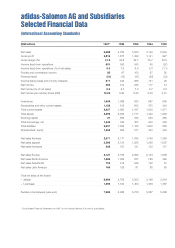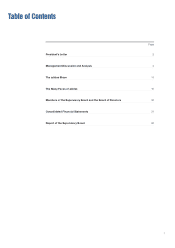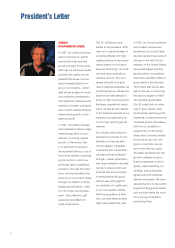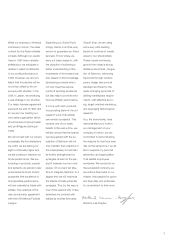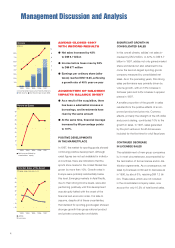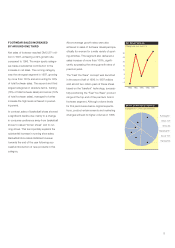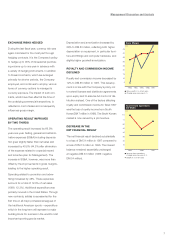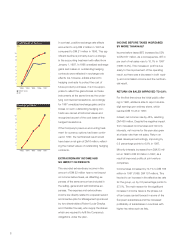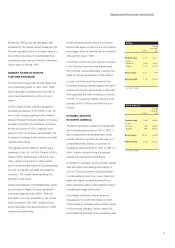Adidas 1997 Annual Report Download - page 12
Download and view the complete annual report
Please find page 12 of the 1997 Adidas annual report below. You can navigate through the pages in the report by either clicking on the pages listed below, or by using the keyword search tool below to find specific information within the annual report.
Change
year-over-
DM m year
Total net sales 169 +55.3%
of which
Footwear 136 +51.4%
Apparel 21 +179.6%
Gross margin 33.3% –1 PP
Change
year-over-
DM m year
Total net sales 703 +69.0%
of which
Footwear 320 +48.9%
Apparel 325 +84.8%
Gross margin 40.9% +2.8 PP
10
Further contributions to this success also
came from the tennis and soccer categories,
as well as the kids’ and women’s segments.
After an initially weak
sales performance at the
begin
ning of the year, the basketball category
picked up momentum, primarily driven by
Kobe Bryant’s signature shoe – the KB8.
Its launch in November was followed by
remarkably high sell-through rates at retailers.
Net sales of apparel increased by 91%, out-
performing growth in footwear sales. At
DM 834 million, apparel generated almost
50% of total sales. The stron
gest growth in
apparel was seen in the segments for women
and for kids aged 8 – 20, both of which in-
creased by around 150%.
Signings with the National Football League
(NFL), the New York Yankees, America’s
best-known baseball team, the Universities of
Notre Dame, Tennessee and Northwestern
in the college sport sector, as well as with a
number of young basketball players, will
make
adidas more visible in North America. This
huge commitment to promotion and the
associated media expenditure puts adidas in
a good position to increase brand visibility
and continue to expand market share in the
North American market.
ASIA/PACIFIC PERFORMED WELL
DESPITE CURRENCY CRISIS
Despite the Asian currency crisis triggered
by the floating of the Thai baht on July 2,
1997, net sales in the region increased by
69% to DM 703 million in 1997, with signifi-
cant contributions to the growth in net sales
coming from the inclusion of the first full-year
effect of the joint venture company in South
Korea and the subsidiary in Taiwan. Exclud-
ing the effects of new companies, net sales
in Asia increased by 38%.
Apparel was the major growth driver for
adidas, increasing by 85% to DM 325 mil-
lion. In footwear, net sales grew by 49% to
DM 320 million, primarily driven by the run-
ning and all-purpose categories.
Top performing countries included New Zea-
land (+79%), Australia (+53%) and the Philip-
pines (+46%), an indication of the success to
be achieved via the strategy of establish
ing
wholly or majority-owned subsidiaries, as
implemented in these countries in 1995 and
1996.
In Japan, one of Asia’s key markets, adidas
was still represented solely by licensees. Sales
under license in Japan in 1997 decreased
by 8%. Royalty income, however, remained
stable
. Upon expiry of the major license
agree-
ment at the end of 1998, adidas will have a
fully-controlled sales organization in Japan
from 1999 onward. This should enable adidas
to market the adidas products and pursue
brand objectives more effectively in Japan.
In 1998, adidas will make use of the new NBA
star Kobe Bryant and major international
sports events, such as the Olympic Winter
Games in Nagano/Japan, the Soccer World
Cup in France, the Commonwealth Games
and the Asian Games, in order to further
strengthen the brand image in the region. All
these events will be accompanied by the as-
sociated advertising and promotion activities.
Despite the anticipated negative impact on
sales figures as a result of the Asian currency
crisis and the related increasing pressure on
margins, in 1998 adidas management is
aiming to achieve the same level of net sales
as in 1997. This aim is supported by the fact
that the economic crisis is not showing any
appreciable effects in several of adidas’ key
countries in the Asia/Pacific region, such as
Australia, New Zealand or Hong Kong.
Asia/Pacific
Latin America


